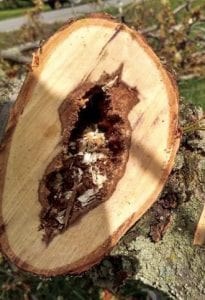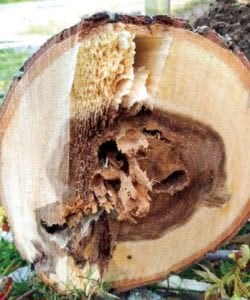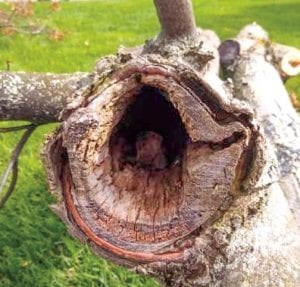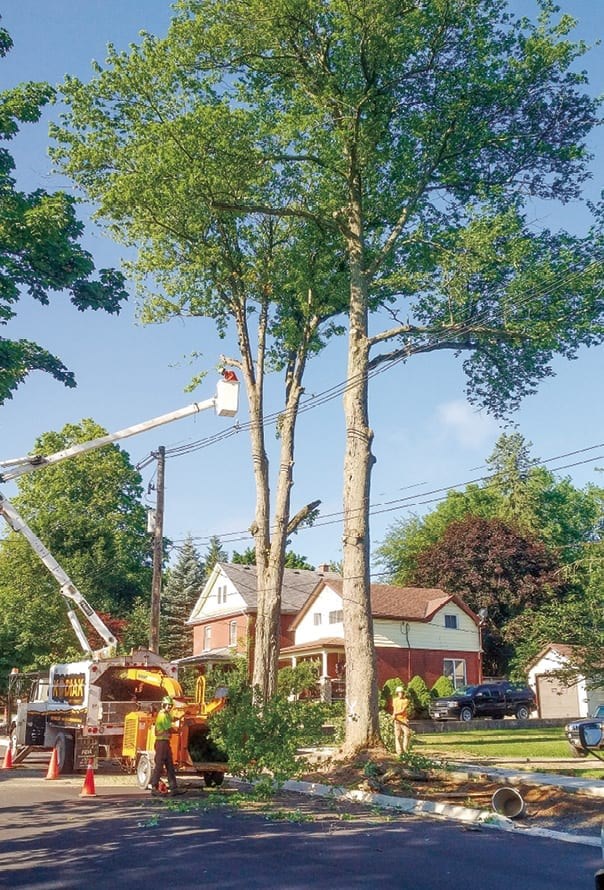Loss of mature trees in Fonthill has residents calling for policy changes
Should the mature Silver Maple on Station Street in Fonthill have been removed or not? Voice readers over the last couple of weeks will be aware that there are concerns among some residents that a “perfectly healthy” tree was cut down for little apparent reason. Town staff, bolstered by an assessment from an independent arborist, say that the tree was diseased and due for removal for safety reasons. Councilor John Wink became involved, hoping to mediate a solution, but finally conceded, “I find us at an impasse.” The Town’s Chief Administrative Officer, David Cribbs, concurs. In an email to resident Cari Pupo, one of those protesting the removal, he concludes, “I do not believe that further discourse on this matter is likely to be fruitful.”
How did we get to this point? The tree at issue was a mature Silver Maple of about 60 feet in height on Town property in front of a single-family residence on Station Street. The homeowners cited damage to their house and vehicle from falling branches and dangerously poor sightlines along Station from their driveway in asking the Town to consider removing the tree.
The Town’s Supervisor of Beautification (yes, there is such a thing) and an independent arborist, Marcus Michaud, hired by the Town to do an assessment, agreed that the tree was compromised and in poor health. The Town did not make the removal a priority and the pandemic further slowed any action, so the homeowners offered to remove it at their own expense rather than wait for the Town to do the work.
The arborist’s report noted “moderate tip die-back which is a symptom of root damage.” He went on, “sidewalk construction, ditch maintenance and the excavation for the driveway are the reason this tree had basal rot and needed to be removed. I also believe that regular pruning from hydro was causing stress to this tree.”
His report included eight pages of pictures illustrating the “basal rot” in the heartwood of the stump and nests of ants living in the rotted core. In hindsight, Michaud maintains, the Silver Maple should never have been planted in that location in the first place. “Silver Maples are quickly growing trees and become very large, these are not the type of tree that should be planted where infrastructure will be built.”

 Even so, if a “root protection zone” had been established to shield the roots from construction such as the driveway and infrastructure maintenance, “I strongly believe the tree would have been in better health.” In sum, the tree was suffering and a potential hazard to the homeowners and passersby.
Even so, if a “root protection zone” had been established to shield the roots from construction such as the driveway and infrastructure maintenance, “I strongly believe the tree would have been in better health.” In sum, the tree was suffering and a potential hazard to the homeowners and passersby.
Residents Mike and Carol Jones disagree. Mike Jones was woken by the sound of chainsaws on the Saturday of a long weekend, which was the first he knew of plans to remove the Station Street tree. He confronted the removal crew but got nowhere. Jones claims that pictures he took of the stump show no rot in the core and, having Googled “stump rot,” he voiced his suspicion that chemicals were poured onto the stump to produce the rot that is evident now. Unfortunately, he has deleted the pictures he took. He further questions why the tree was removed on the Saturday of a long weekend, when Town staff were not available to hear his concerns and stop the chainsaws.

The Town developed a policy called “Urban Forest Guidelines” in 2000 to account for and protect the canopy. Mike and Carol Jones were instrumental in developing these guidelines with Town Staff of the day. Director of Public Works, Jason Marr, acknowledges the existence of these guidelines, but points out, “Many of the tasks identified in this guideline are not achievable based on the current funding and resources available to the public works department. In 2016 a new forestry and tree policy was presented to council by staff and adopted. This policy is very vague at best.”
Many of the tasks identified in this guideline are not achievable based on the current funding and resources available to the public works department
He promises to develop a new and workable policy for presentation to council, “hopefully this fall. It will most likely also include additional resources required to implement such a policy.”
Meanwhile, across town, Graham and Eddie Pett expressed their concern about the Town’s tree policy last week in a letter to the Voice in support of the Jones letter. Coincidentally, this week they experienced the issue firsthand when two large maples were cut down on North Pelham Street near their home. Graham Pett contacted the Town and was given the underlying reason for the removal of the trees, an explanation he doesn’t entirely buy: “There is some evident rationale for this destruction (if one trusts the so-called ‘experts’).” Like the Station Street tree, the two on North Pelham were compromised by construction that had damaged the roots sufficiently that in the Town’s opinion, the trees would become a hazard. Though upset by the destruction of trees he saw as healthy, Graham Pett’s main complaint is that there was little forewarning of the work to allow for residents to question the decision or get an explanation in advance of the trees coming down.

The issue may come down to transparency (an oft-used word in Pelham, it seems). When asked whether he would have been satisfied if the Station Street tree had been marked a few weeks in advance of cutting, allowing time to question the necessity of the removal, Mike Jones said yes. The arborist’s report may not have satisfied him, but at least he would have been able to have his say before it was too late. He feels that what is necessary is “a process where citizens have a chance to know what trees are to be removed in their neighbourhood and be able to have a say or second opinion (at their own cost).”
Graham Pett, too, feels that prior notification and a chance to review the evidence in favour of removal are necessary steps: “We’re trying to take the high road here with a view that Pelham needs to become a lot … greener and to avoid this kind of shock when two wonderful trees (actually three, as one was taken much earlier in the project) that have been in your lives for 40 some years are turned to sawdust in a blink of an eye.”
In a statement to the Voice, CAO David Cribbs also sounded a conciliatory note: “The frustration of the individuals contacting the Town is understandable, and their dedication and passion for Pelham’s trees is commended. We all have a vested interest to maintain the Town’s tree canopy, which the Town demonstrates by its investments in controlling the gypsy moth, by employing an arborist, and by having an annual budget for tree trimming and removal. The loss of a mature tree is always a sad occurrence and unfortunately it happens on a continuous basis.”


